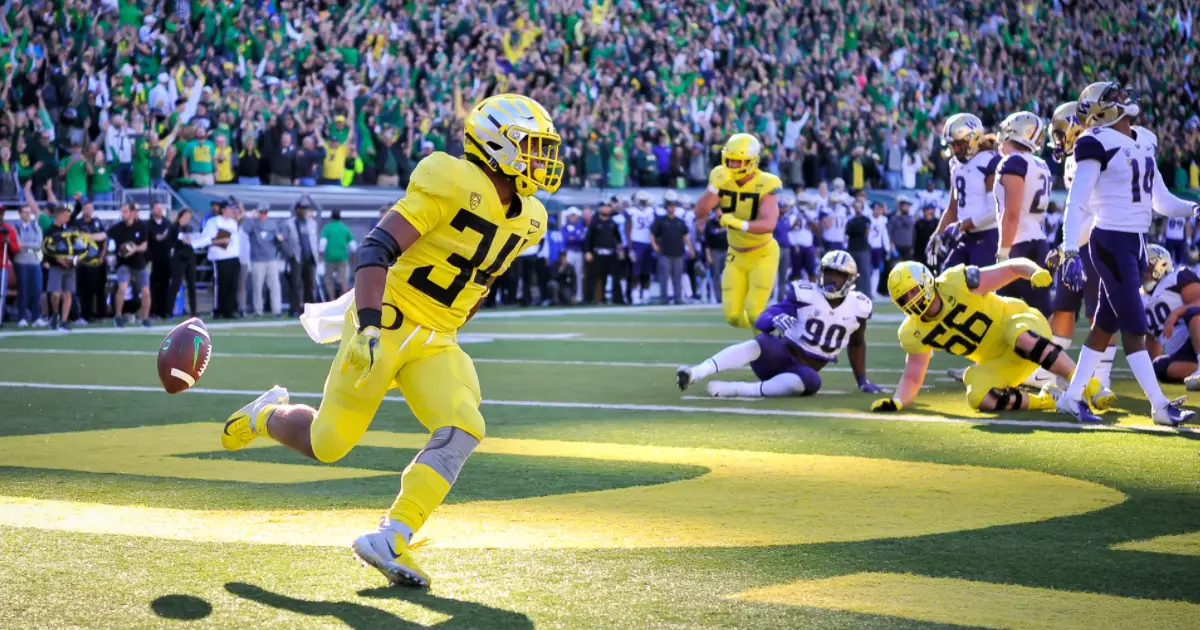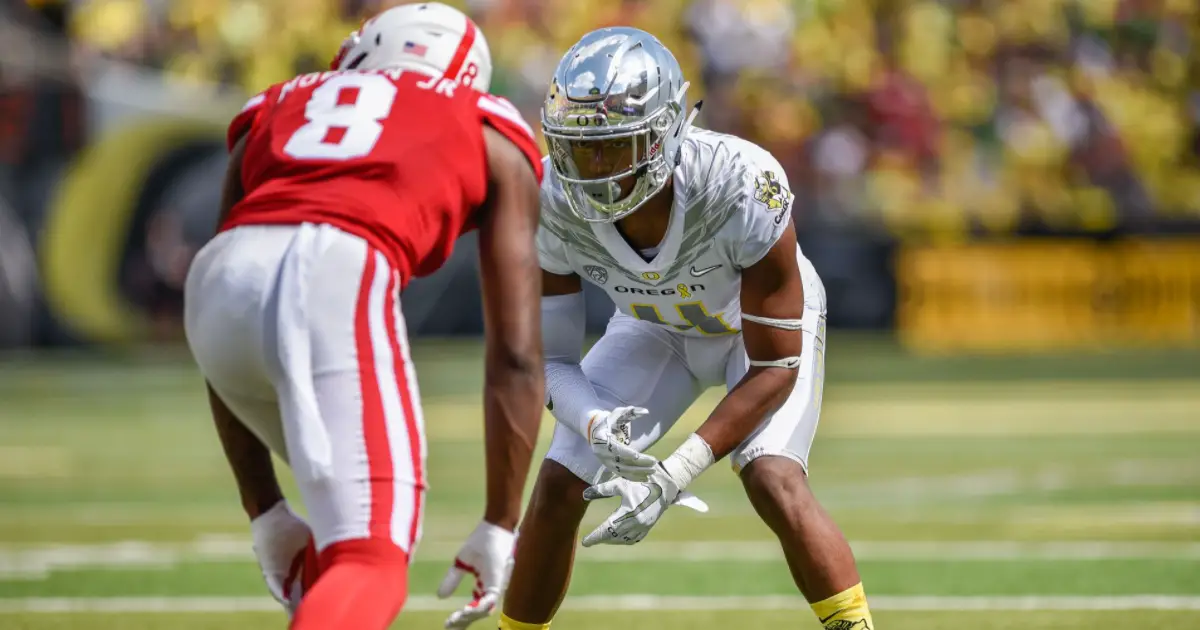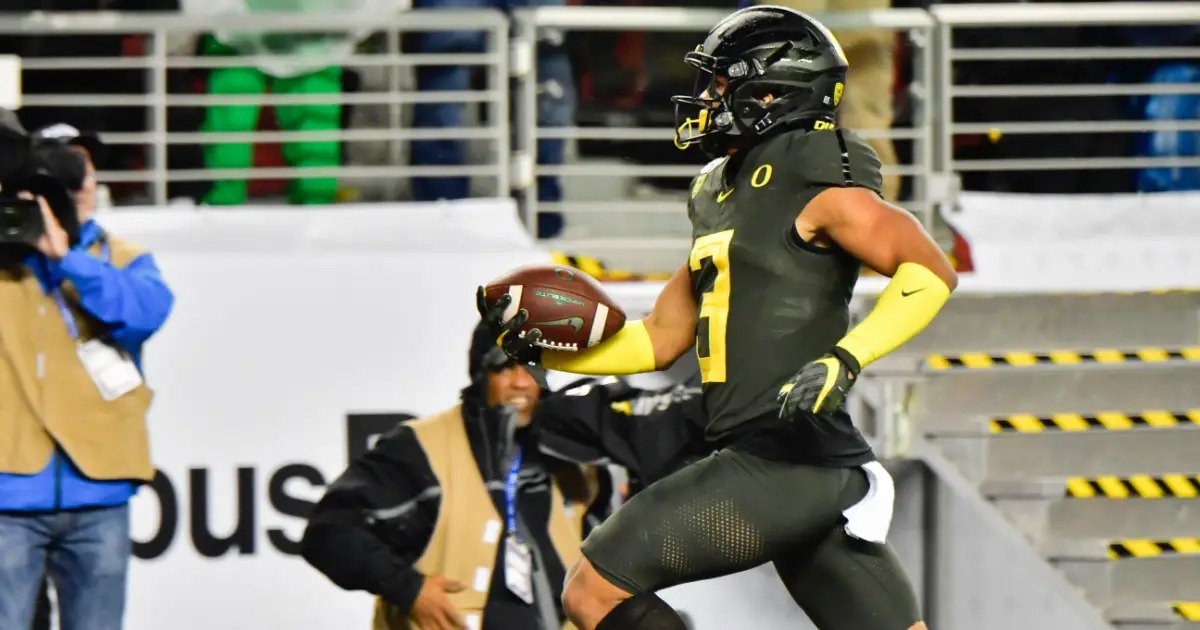2016 was arguably the worst year in modern Oregon Football history. It was such a juxtaposition from the two national runner-up campaigns, the Heisman trophy win, the innovation and past excitement, that at the time, felt almost like the program was on the verge of death. Rob Mullins brought in journeyman and expert recruiter Willie Taggart to try and save the once great program.
Taggart did not stay long, but his impact on the future of Oregon football was immense, and it all started with the class that he cobbled together with only a few weeks of recruiting.
Impactful Offensive Players
Offensively the 2017 recruiting class had a few good players who have carved out long-term roles with the team. With only nine of the 26 players being signed on the offensive side of the ball (although Jaylon Redd would switch to slot receiver, bringing the total to 10), it would’ve been easy for the 2017 class to have little to no impact on that side of the ball.
Braxton Burmeister flamed out in Eugene after the coaching staff failed to develop him in any meaningful way during the spring and fall, and when Justin Herbert went down with an injury and Burmeister was thrown to the proverbial wolves, he looked lost and like he couldn’t throw the ball. His time at Virginia Tech has proven that the initial assessment that he simply couldn’t play QB in college was incorrect. Overall, the 2017 class didn’t provide any breakout stars at QB.
On the offensive line George Moore and Alex Forsyth have become mainstays in the rotation. Moore has been in college for seemingly forever, after playing for the College of San Mateo in the JuCo ranks before signing with the Ducks. Forsyth has reportedly been a leader in the unit during spring camp, and projects to start at center for the second consecutive year.

CJ Verdell had one of the greatest moments in program history, scoring the game-winning TD against UW.
At running back CJ Verdell has been the starter for years now, and he rushed for the game-winning touchdown against Washington in 2018, one of the defining moments in school history. Cyrus Habibi-Likio was the goal line back for three years under Mario Cristobal, and although he never carved out a role as a full-time back, his 21 rushing touchdowns are tied with Verdell for the most since the two signed with the school.
At wide receiver, the aforementioned Redd has been a touchdown machine, scoring 19 times by either rushing or receiving. Johnny Johnson III has easily been the most consistent receiver on the roster since his sophomore year, having amassed 1,617 yards and 14 touchdowns. Johnson and Redd have been glimmers of light in an otherwise unimpressive receiving corps over their careers.
Program Changing Defensive Stars
The 2016 Oregon defense stands as the worst in school history to this day, and it is unlikely to be surpassed at any point in the future. The team was incapable of defending the pass, and when they appeared to make an effort to do so, their form was so poor that they almost always committed pass interference. They were equally incompetent at stopping the run, as they (except for Troy Dye and Justin Hollins) could get off no blocks, and were extremely poor at tackling. The 2017 recruiting class provided impact players all over the field on day one.
The defensive line was sorry in 2016. They generated almost no QB pressure, very few tackles-for-loss, and exactly zero forced fumbles. Taggart saw this fact, and brought in Austin Faoliu and Jordon Scott. Scott was immediately an integral part of the defense as his six-foot-one 320-lb frame was something that the Ducks simply did not have. Scott finished his career with more than 100 tackles as a nose tackle, a position meant to eat up blocks, not generate stats. Faoliu didn’t have quite the impressive size of Scott, but also generated over 100 career tackles to go along with six total sacks. Both players came in as only three-star prospects, but have left the program as probable day three draft picks.
At linebacker the Ducks brought in Isaac Slade-Matautia and Sampson Niu, two players who have been solid starters, but not stars for the Ducks. The pair has combined for 196 total tackles, 17 tackles for loss, 4.5 sacks, an interception and a fumble. They have surpassed the meager expectations of the defense set the year before they arrived in Eugene.

Thomas Graham was one of the greatest lockdown corners in school history.
Cornerback is where this class truly shines. Sure, the defensive linemen changed the makeup of the defense by being bigger and better in the trenches than Oregon had been in a few years, but the corners became the foundation of a secondary that remains arguably the best unit on the team to this day. Thomas Graham Jr. came in and started every game his freshman year. He finished his career with 183 tackles and eight interceptions, including a two interception performance against Nebraska in his second ever game. Graham goes down as one of the most impactful CB’s in school history.
Deommodore Lenoir wasn’t quite as impactful as a freshman, but kept getting better and better, culminating in a fantastic junior season where he had arguably passed Graham as a playmaker. The two cornerbacks changed the complexion of a room that sorely needed stars, and their impact is still felt in the program today. Both Graham and Lenoir will be rewarded later this month in the draft.
At safety, Nick Pickett was a foundational piece of the best individual position group on the team for the last several years. He finished his career with 165 total tackles and two interceptions. Pickett didn’t start a ton until his senior season when he grabbed the vacancy left by Jevon Holland. The impact of Pickett could be felt immediately in his ability to prevent QBs from attempting deep passes more than intercepting passes they did throw. He was also a solid tackler in space, stepping up to make tackles on passes completed underneath.
Overall the 2017 class had a huge impact on the program, propelling the team to a bowl game a year after a miserable season. Their impact on changing the culture of the team will be felt for years to come.
Ryan Robertson
Yuma, Arizona
Top Photo By Eugene Johnson
Related Articles:
Oregon Enters Playoffs Better Off Than Last Year
Will The Coaching Carousel Kill Oregon's CFP Chances?
The Playoff Formula Hasn't Changed
Oregon Aims to Bury Dawgs, Punch Playoff Ticket in Rivalry Clash
Huskies Are the New Beavers, Stay In Your Lane Kiffin, and the Civil Apple Cup War
Oregon Football: The X-Factor Vs. Washington
Ryan Robertson is a defense contractor for the United States Marine Corps. A lifelong Duck fan from Grants Pass, he joined the Army out of high school. After four years as an Intelligence Analyst he decided it was time to further his education and pay more attention to his Ducks. One of Ryan’s first memories is of watching the Ducks, led by Joey Harrington, beating up on the Utah Utes in 2001. His grandfather ran track at Oregon in the ‘50s. He loves the Ducks, and has a passionate interest in reading every scrap of analysis centered around the football team.

